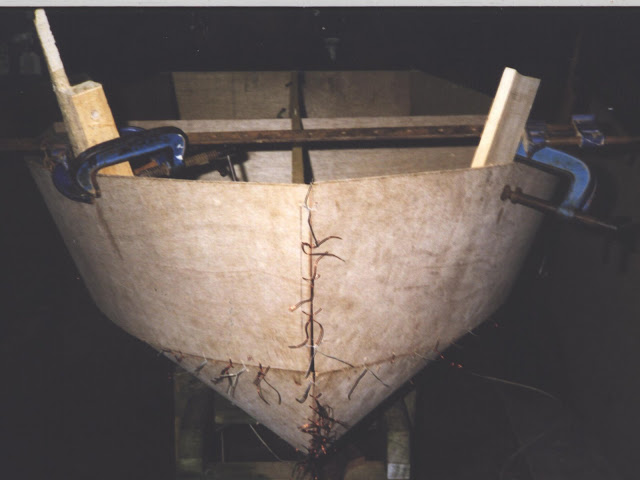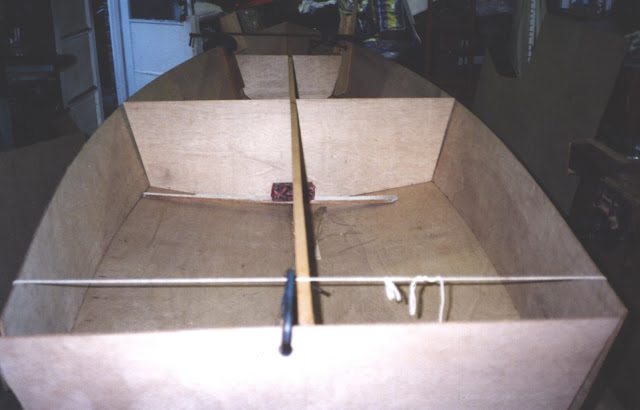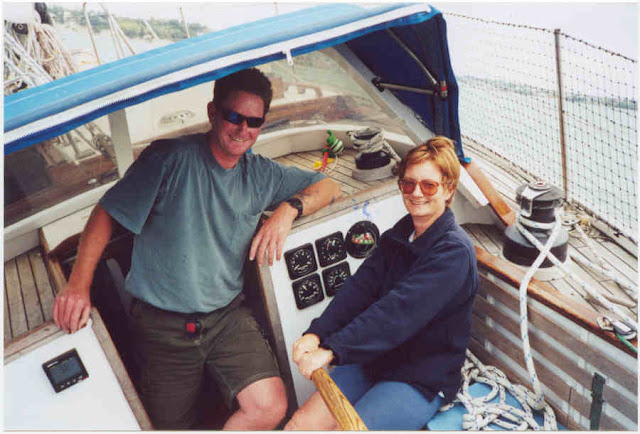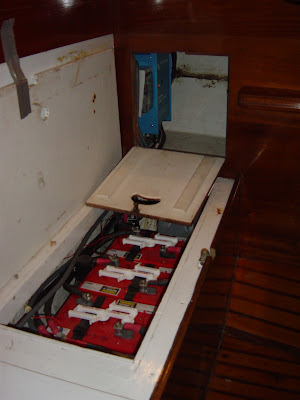Gitana 43 "Blue Heron"
The Gitana 43 is one of the best-kept secrets when it comes to offshore cruising design.Built and designed in South Africa by a German designer, with a hull shape aimed at comfort, control, and speed. A real pleasure to sail. Also, check out this link; https://www.youtube.com/user/ToSeeTheSea
Monday 1 September 2008
Friday 15 August 2008
Putting it all to the test
We finally managed to slip the mooring lines, having completed the majority of all the jobs and head north to warmer climates.
Check out the new movies I’ve posted on YouTube http://au.youtube.com/user/ToSeeTheSea .
We had a great passage with only the generator causing us any grief.
Check out the new movies I’ve posted on YouTube http://au.youtube.com/user/ToSeeTheSea .
We had a great passage with only the generator causing us any grief.
Sunday 10 August 2008
The Pre Passage Work List
Before heading offshore there is a tendency to go a little mad in terms of work on the boat. This is what I achieved.
Notice how the momentum increases as the departure date of 4th August gets closer. Some jobs were completed on passage, others are yet to be completed. We are now in island time, which means everything that can be done the next day is left until tomorrow.

Notice how the momentum increases as the departure date of 4th August gets closer. Some jobs were completed on passage, others are yet to be completed. We are now in island time, which means everything that can be done the next day is left until tomorrow.
Click the list to enlarge it.

Click the list to enlarge it.  Click the list to enlarge it.
Click the list to enlarge it.
 Click the list to enlarge it.
Click the list to enlarge it.Wednesday 4 June 2008
The Big Refit
Of course, when you make the decision to undertake a project of this scale, the opportunity to fix other things you don't like cannot be ignored.
The 24-year-old teak decks were showing signs that water was getting through to some parts of the Plywood base. We knew when we bought Blue Heron that we would have to deal with this issue.
The Teak was removed by Sawing across the planks then chiseling it off in small chunks.

The winches were too far outboard.
I was never comfortable relying on a bit of canvas to prevent water getting below through the hole in the cockpit required for the tiller to attach to the rudder stock.
The 24-year-old teak decks were showing signs that water was getting through to some parts of the Plywood base. We knew when we bought Blue Heron that we would have to deal with this issue.

The Teak was removed by Sawing across the planks then chiseling it off in small chunks.

The winches were too far outboard.
I was never comfortable relying on a bit of canvas to prevent water getting below through the hole in the cockpit required for the tiller to attach to the rudder stock.
Thursday 13 March 2008
Yacht Photos
These Photos were taken by Will at http://www.oceanphotography.co.nz/
The next two photos were taken during the start of the 2005 Coastal Classic Yacht race from Auckland's Waitemata Harbour to Russell in the Bay of Islands.
The race is very popular with over 230 yachts racing up the coast each year in October over Labour weekend holidays.
The race is very popular with over 230 yachts racing up the coast each year in October over Labour weekend holidays.
I was happy enough with an average speed of 8.2 Knots over the 112 Nautical Mile race.
Saturday 16 February 2008
Yacht "Blue Heron" Building the Tender
I think I went a bit over the top in terms of ensuring the join was well pressed together (see photo), but got the desired result.
First, you need to work out what size and design you want.
Then you need to get hold of some plans. Check out the link on the left for B and B yacht designs.

Don't take shortcuts. In these photos, you can see I didn't follow the plans that well. The whole bow including the topsides should have been joined together first. I had a hell of a job getting the topsides to come together evenly.
To be fair on myself, the garage I had borrowed to do the project didn't have enough room to use the method in the plans, (see the link to the left).

But we got there eventually.
Thank you for inventing the West System Epoxy and fillers for hiding less than perfect workmanship. Who cares about the extra weight.
 Remember to triple check the measurements for the dividing bulkheads where the hull is cut in half. My wee error was fortunately in my favour and worked out well. If the error had gone the other way, I'd not have got the bow section inside the aft section.
Remember to triple check the measurements for the dividing bulkheads where the hull is cut in half. My wee error was fortunately in my favour and worked out well. If the error had gone the other way, I'd not have got the bow section inside the aft section.The work progressed steadily over the winter months.
Mostly I worked on it after work in the evening but the weekends were good for achieving so much more. It took up all of my spare time for about four months.
In the weekends the crew would pop around for a while and give a hand with the sanding.

From then on it was lots of filling fairing and sanding. Not the most fun part of the project for me.

A Quick trip to Whangarei on the trailer to make use of my fathers

We used an air spray gun to apply the three shades of two pot paint system from Wairau Paints.

Then we Glued the closed cell foam onto the rubbing strake and covered it with Hypolon strap using Lancer Industries Two Pot contact adhesive.
I was amazed at how much time went into painting and finishing it. Probably about a third of the build time. In part due to the three colours that were each individually masked.
Back to Auckland for "Lawn Trials", which the kids informed me it passed with flying colours.
 Then came the official launching at Gulf Harbour Marina, Whangaparaoa Peninsular, where "Blue Heron" was berthed.
Then came the official launching at Gulf Harbour Marina, Whangaparaoa Peninsular, where "Blue Heron" was berthed. It looked just fine sitting alongside.
It looked just fine sitting alongside.Fitted in place for offshore passages in the nested position the 11 foot long boat only took up 6 foot deck space. Nice and snug.
 True to the designers claims, it was fast. Hamish (9) and Dad (?) both won first prize at the Devonport Yacht club beach sports day rowing races, held at home bay Motutapu Island.
True to the designers claims, it was fast. Hamish (9) and Dad (?) both won first prize at the Devonport Yacht club beach sports day rowing races, held at home bay Motutapu Island.It is a favourite pastime for Hamish to go for a blat around the bay. Seen here with a five hourse Yamaha. It is super quick with the new eight hourse Yamaha.

It sails well. I used a full laser rig but have puchased a laser radial rig for when the wind is up a bit. It floats high and leaves most of the water outside the boat when righted after a capsize. It planes like a skiff when the wind is up, great fun.
And it tows really well, even in a chop.

We got what we wanted in a dinghy. It is a bit of a pain having to put it all together and stow it when the weather is expected to be less than ideal and we are passaging. This is nothing in comparrison to having a tender that is as versitile as our Spindrift 11 Nesting Dinghy. We named her "MyST" (My Spare Time).
Friday 15 February 2008
Yacht "Blue Heron" The Refit Starts - Winter 2003 - Electrical System
The 20-year-old electrical system had been added onto over the years.

It wasn't until a really close look behind the scene was undertaken that the reason for the odd light flicker became apparent. Many of the old copper wires were joined with chocky blocks that had green copper ends held in place by the screws. The resistance created by the corrosion had created so much heat at some time in the past, the plastic surrounds of the chocky blocks had melted in some cases.

New BEP AC and DC Switchboards, not cheap but good value.



It wasn't until a really close look behind the scene was undertaken that the reason for the odd light flicker became apparent. Many of the old copper wires were joined with chocky blocks that had green copper ends held in place by the screws. The resistance created by the corrosion had created so much heat at some time in the past, the plastic surrounds of the chocky blocks had melted in some cases.
DC power has a reputation for creating fires if enough corrosion/resistance/heat is allowed to build up.
An Opportnity to build a new bookcase is too hard to resist.
What to do with the old bookcase hole. More thinking and planning required.
What to do with the old bookcase hole. More thinking and planning required.

New BEP AC and DC Switchboards, not cheap but good value.
A cheap ICOM GPS that didn't last a year before it decided to retire.
At this stage, more than 300 meters of marine grade (tinned) 1.5mm and 2mm wire had been run through the 13 metre long boat, and vertually non of it vissible. It's amazing where it all goes.
Drilling holes in bulkheads is not a good feeling. At times the access points are virtually inaccessable. I knew I should have kept up those yoga classes.

Then there was the 50mm and 75mm marine grade wire that ran fore and aft from the generator and main engine through the BEP heavy duty Switches and blocking Diodes (located in the old battery box) to the new Victron AC 50 Amp battery charger and the new 440 Amp bank of six volt lead acid house batteries. And the new Lofrans Windlass on the foredeck, 2 x 10 meters away there and back.
Thanks World Power for doing all the heavy work and teaching me how to do the light stuff right.

Notice how I sacrificed a water tank (with a 100 litre bladder) for the new easy access house battery stowage. Getting easy access to maintain these expensive, easily abused batteries is important if you want to get your money's worth out of them.
But thats another story. Stay posted.
Yacht "Blue Heron" Getting to know the boats secrets.
We cruised on Blue Heron for three years on the New Zealand, North Island, NE coast when our various work commitments and projects allowed.

Here she is anchored off Russel in the Bay of Islands.
The teak woodwork looked great varnished, but we soon worked out it would be a lot of work to keep looking good on the outside.

We were really pleased with the way she handled, despite having a baggy old mainsail. She is a relatively comfortable yacht offshore, although the confused sea around Cape Brett had the crew feeling a little queazy.
In a building breeze from the east, we sailed back from Great Barrier Island reaching speeds of 12 knots across the ground with a single reef in the main and poled out Headsail (Number 3) and wind peaking at 27 knots.

There were aspects of the boat we were not comfortable with in terms of ocean passaging that had to be put right. We had no passive income and felt the work should be done before we departed New Zealand.
The position of the gauges annoyed me for one and they told lies.
The Position of the Mainsheet winch was silly and it wasn't up to the job.
The echosounder beeped (a lot).

The list started ;

Here she is anchored off Russel in the Bay of Islands.
The teak woodwork looked great varnished, but we soon worked out it would be a lot of work to keep looking good on the outside.

We were really pleased with the way she handled, despite having a baggy old mainsail. She is a relatively comfortable yacht offshore, although the confused sea around Cape Brett had the crew feeling a little queazy.
In a building breeze from the east, we sailed back from Great Barrier Island reaching speeds of 12 knots across the ground with a single reef in the main and poled out Headsail (Number 3) and wind peaking at 27 knots.

There were aspects of the boat we were not comfortable with in terms of ocean passaging that had to be put right. We had no passive income and felt the work should be done before we departed New Zealand.
The position of the gauges annoyed me for one and they told lies.
The Position of the Mainsheet winch was silly and it wasn't up to the job.
The echosounder beeped (a lot).

The list started ;
- Investigate wet spots in Teak Deck. (More on this later)
- Improve the dodger.
- Replace the Standing Rigging
- Replace all running Rigging
- Replace the 20-year-old foresail furler
- Add a Trysail track to the mast
- Improve the Spinnaker pole track system
- Rebuild the waterlogged rudder
- Treat Osmosis
- Sort out the electrical systems
Tuesday 17 April 2007
Yacht "Blue Heron" Finding Blue Heron

We found Blue Heron advertised with a small add at the back of New Zealand Boating Magazine, showing her anchored in Tahiti.
She was moored in Lyttleton Harbour near Christchurch. We got all the sales information sent up. A good friend had a look at her for us and sent up more photos and we decided she was worth a closer look.
The weekend before I was due to fly down to Lyttleton, a bad storm destroyed the partly finished Marina. Dozens of boats were sunk, some very sad stories of 12-year restorations sent to the bottom. Blue Heron must have been the luckiest boat in the Marina, as it was hauled out the day before the storm hit.
 The owner couldn't sleep aboard during the height of the storm as she was shaking in her cradle so violently, so chose instead to sleep in his car.
The owner couldn't sleep aboard during the height of the storm as she was shaking in her cradle so violently, so chose instead to sleep in his car.
First impressions were not good. She had an underwater shape aft of the keel that was very different to anything I'd seen before (and I'd seen a lot). Keeping an open mind I continued to look.
 The moment I walked inside I was sold. The interior woodwork and layout were stunning. Six-foot minimum headroom all the way through, despite the flush decks. Three separate living areas, two companionways, heads and bathroom aft. The best layout for a family cruising boat I had seen yet in our price range. After much deliberation, we agreed to buy her. I flew back to Auckland and returned to Lyttleton in December 2000 with a delivery crew to take possession and sail her back to Auckland. It was a good thing that she was reasonable to windward as we had headwinds the whole way. Every Cape we rounded during the 800-mile passage, the wind changed to head us.
The moment I walked inside I was sold. The interior woodwork and layout were stunning. Six-foot minimum headroom all the way through, despite the flush decks. Three separate living areas, two companionways, heads and bathroom aft. The best layout for a family cruising boat I had seen yet in our price range. After much deliberation, we agreed to buy her. I flew back to Auckland and returned to Lyttleton in December 2000 with a delivery crew to take possession and sail her back to Auckland. It was a good thing that she was reasonable to windward as we had headwinds the whole way. Every Cape we rounded during the 800-mile passage, the wind changed to head us.Sunday 15 April 2007
Introducing Yacht "Blue Heron"
Blue Heron was Launched in 1981 at Cape Town, South Africa.
- Length; 43 ft / 13 m
- Construction; Fibreglass Hull, Glass over Ply decks
- Designer; Oswald Berckemeyer
- Class; Gitana 43
- Weight; 13 Ton
- Draught; 6 foot /2.1 meters
- Engine; 40 hp, four cylinders, Kubota
- Generator; 6 hp Petter with 4 kva AC Alternator
- Rig; Cutter Rig Sloop, Aluminum Spars
- Keel; Fin with stainless steel bolts
- Rudder; Spade - Balanced
- Propeller; KiwiProp 3 blade feathering
- Steering; Tiller, Aires, T2 AutoHelm Smart Pilot
- Anchor; Rocna (very very good)
- Interior; solid Sapali, Origin Pine, and Plywood
Subscribe to:
Posts (Atom)




















